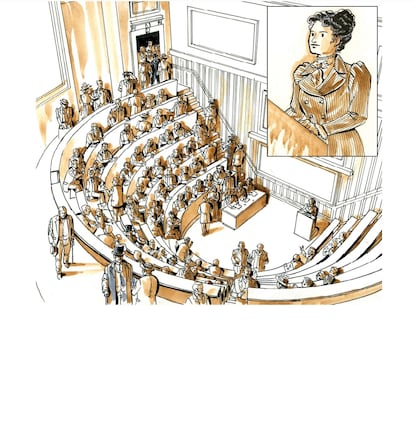It’s nothing more than a sponge. And it does what everyone does: when it touches the water, it swells. But the girl watches fascinated. When it’s her turn, she takes it out of the bowl, waits for every last drop to drip out, and carefully transfers it to another container. Only then does she squeeze it. Not a stain along the way. What satisfaction! “This activity seems like a small thing, but it harbors many secrets!” says Maria Montessori (1870-1952) in the recent comic recreation of a presentation by her students, back in 1909. The experiment also contains the answer to another enigma: why an Italian educator from the first half of the 20th century has achieved legendary status.
Hard to find someone who doesn’t know her. Almost impossible in the case of mothers and fathers. Pedagogy reference. Philosopher, doctor, anthropologist. Visionary. Three-time candidate for the Nobel Peace Prize. Pioneer symbol of the feminist struggle. Executioner and victim of patriarchy. In recent weeks, a film and a graphic novel have heightened her interest in her life, her figure, and her complex relationship with motherhood. And, at the same time, a criticized essay tries to overshadow it. Although she doesn’t need more spotlights either: her example is renewed every day in homes and classrooms across half the planet. In her books, Education and peace a Educate in human potential. And in all types of marketing more or less consistent with its original message. “To educate them, above all we have loved them,” she sums it up in the film by French director Léa Todorov. Titled, just like the comic, Maria Montessori. Another example of the power of its simple name.
“His ideas transcend time because they are based on the observation of the functioning of the child’s brain. Today families are very aware of their children and reevaluate the Montessori method. Concrete, experimental, based on personal and hands-on interaction, it is also the ideal cure for the digital,” reflects Cristina de Stefano, author of the biography. The child is the teacher (Lumen). Over 380 pages, the author reconstructs an enormous journey that began in 1870 in the small Italian city of Chiaravalle, where she was born, and ended in eternity. “Since she launched the first Children Houseon January 6, 1907, there is a before and after in early childhood education,” reads the website of the Spanish Montessori Association (AME), one of hundreds of similar entities around the world.
The comic by Caroline Lepeu and Jérôme Mondolini, published in Spanish by Andana (also in Catalan), begins with another milestone: the discussion of her thesis, in 1896. Years later she would become the fifth female doctor in the history of Italy. A woman mastering medicine. Unheard. And yet, it was only the beginning. Because Montessori revolutionized the way we see children. “Help him only if he needs it. And to know what it needs, watch it! Without ever interpreting his words or actions or judging him. He does not need reproaches and applause, but patience and accompaniment,” she points out in the comic.
But first, he dedicated himself to rescuing the most fragile children. Then they were called “idiots” or “deficients,” as reconstructed in another comic entitled with the name of the educator (by Alessio Surian, Diego di Masi and Silvio Boselli, edited by DeBolsillo). One of the many things that have also changed thanks to the work of Montessori. And one of the reasons why Todorov was encouraged to film his debut film.
“My daughter was born with a genetic disease. I quickly understood that she would not just be a mother, but the mother of a child with special needs. And I suffered from the lack of representation of this context, which could have helped me,” shares the director. Hence, she focused throughout on Montessori’s efforts to leave no one behind. And, at the same time, in the personal cost that she paid. She is the savior of all the children in the world, except hers. As Todorov points out, “for a woman born in 1870, it was not enough to be brilliant; It required iron determination and an extraordinary aspiration for success. However, the more energy, the more obstacles she encountered. And to escape the social determinism of the time and her gender, above all she had to give up the most precious thing: Mario.”
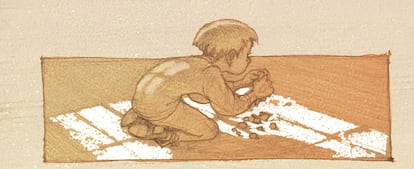
As a result of her extramarital relationship with Dr. Giuseppe Montesano, the boy was hidden with another family in the countryside. Or abandoned, according to critics. Montessori did not dare to raise him, because of the scandal it would entail. But he didn’t want to get married either, out of appreciation for his own freedom. So he went to see him on the weekends. Years must have passed until Mario was finally able to live with his mother. And decades for him to know the truth. Of course, both spent the rest of their lives very close. And his son, who spent a good part of his life in Spain, joined the spreaders of his mother’s word.
“With the Montessori method Children develop in a prepared environment, based on autonomy, independence, initiative, ability to choose, development of will and self-discipline, with the idea that they are their own teachers. “I did not want to create geniuses, but rather give each person the opportunity to develop their own abilities, by themselves and with others,” clarifies the Spanish association that bears her name. “He observed that each child has his own rhythm and interests; With this, she developed materials and presentations according to each learning moment. Neuroscience today supports what Montessori called the ‘absorbent mind’, as that innate ability to learn from the environment, as well as the importance of movement and the senses, through manipulation. This leads us to question chain education, where everyone receives the same information at the same time,” completes Carmen Rodríguez, founder of the website. Montessori for everyone and regular collaborator of the AME.
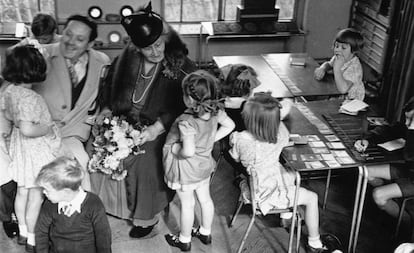
The thinker respected children’s activity so much that she preferred to call it “work,” rather than play. She spoke of “guides,” rather than teachers, and she referred to the child as a “forgotten citizen” or “creator and father of man.” She defended that the boy knows what he is doing. Those who don’t understand, if anything, are the adults. “By observing what children need and adjusting our behaviors to it, we take down the all-powerful adults and their limiting beliefs from the pedestal,” adds Caroline Lepeu. Mother and Montessori educator, she wanted to spread these theories in the most accessible way. And she wrote a comic.
His vignettes add other keys: prior physical preparation; the importance of repetition. Of course, patience. “Without discipline there is no freedom, only abandonment of the child. Without freedom, there is no discipline, but submission,” he points out in the graphic novel. It is true that Montessori also revolutionized the environment: classrooms, furniture and materials had to be tailored to children. Although those interviewed fear that this lesson today has been taken to the extreme or misinterpreted, perhaps on purpose.
Todorov emphasizes that the pedagogue herself somehow started it, by patenting her objects to obtain money and, therefore, freedom, necessary to advance her work. But the trend is already “overused,” according to the filmmaker. There is the “Montessorian” label attached to every type of chair, toy, bookcase, school or behavior.
“Today it is enough to put that word on top of anything to sell,” laments De Stefano. And Lepeu clarifies: “His philosophy does not need to be acquired. “Children do not need Montessori material at home, but rather parents who listen to them.” “Montessori called his classrooms ‘children’s houses’. Adapted furniture, at the right age, will help our children become more autonomous. If a book has real images, children will always be able to better understand their surroundings. But not everything goes. If a material is not offered at the correct time, it does not matter whether or not it has the word Montessori. And when you see the term ‘toy’ next to it, run away! Montessori is a scientific material as long as we as adults learn its use. If not, it becomes just another teaching material,” warns Carmen Rodríguez.
At the same time, Karma Films, the film’s distributor, highlights the bright side of such success. For the 25,000 tickets sold in three weeks in Spain for a very small feature. And because of what is emerging around: “We have received calls and messages from provinces and municipalities where it had not reached the billboard. Different groups related to their pedagogy began to mobilize and organize meetings in special showings in cinemas, on specific days and times, accompanied by colloquiums and round tables with experts and members of the AME. The requests continue. And those from schools and faculties of Education are joining.
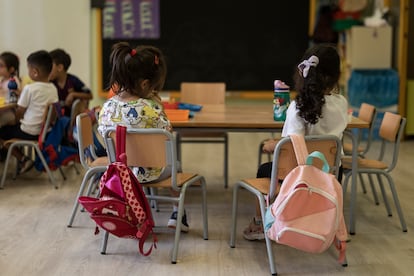
Not everyone, however, shares this enthusiasm. Essay The long shadow of Maria Montessori, from the University of Salzburg professor Sabine Seichter, accuses the thinker of promoting a “racist, eugenic-type” project. And trying to create a “perfect child”, coinciding with the Western Aryan ideal. The publication has caused a scandal in Italy, where dozens of voices have been raised to defend her favorite compatriot. The interviewees also stand in her defense. “In her youth, she had expressions that could scandalize us today, when she measured skulls, but they were the ideas of positivism of her time. In her letters I did not find a single word that would justify accusing her of racism,” De Stefano remarks.
Her alleged closeness to the fascist dictator Benito Mussolini has also been questioned, although the regime ended up closing her schools and she herself fled to Spain and then the Netherlands, in the face of the totalitarian advance. “Today nationalists and internationalists are equally committed to indoctrinating both children and adults,” she denounced before the League of Nations in Geneva in 1929. And certain phrases, read now, even place her in anti-capitalism (“ There is no competition. If everyone did what they were made to do, the world would be much better”) or very much in favor of the welfare state (“When a wasteful society has an extreme need for money, it even takes it away from schools ( …) It is one of the most unequal crimes of humanity and the most absurd of its errors,” he wrote in The child, the secret of childhood).
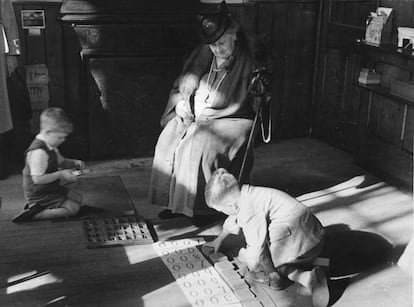
Perhaps, when looking for a drawback, it is just the opposite: the risk of hagiography. Such an impeccable portrait evokes an icon, rather than a real woman. Like the one in which, at one point in the film, she suddenly loses her patience and her roles. There, for once, the viewer glimpses a human weakness. Just the distance between the fame of her method and the little information about her motivated De Stefano to write her biography. After finishing it, he describes her like this: “A very intelligent, modern and transgressive woman. One of the many that, between the end of the 19th century and the beginning of the 20th, changed the world. She wanted to study medicine when only going to university was an exception for a woman. She refused to marry, even when she became pregnant. She went to retrieve her teenage son, who had been taken from her. She founded a successful company, recording her material. “She faced the sudden, global celebrity without being scared, leaving the provincial Italy of the time to go conquer the world.”
He died on May 6, 1952, at the age of 82, in the Netherlands. His tombstone in Noordwijk reads: “I beg the dear children, who can do anything, to join me in building peace among men and in the world.” The last lesson. Maybe one day the world will learn it.
Subscribe to continue reading
Read without limits
_

